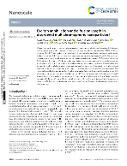Exciton annihilation and diffusion length in disordered multichromophoric nanoparticles

Autor
Gharbi, Amira Mounya
Biswas, Deep Sekhar
Cregut, Olivier
Datum vydání
2024Publikováno v
NanoscaleRočník / Číslo vydání
16 (24)ISBN / ISSN
ISSN: 2040-3364ISBN / ISSN
eISSN: 2040-3372Informace o financování
UK/COOP/COOP
Metadata
Zobrazit celý záznamKolekce
Tato publikace má vydavatelskou verzi s DOI 10.1039/d4nr00325j
Abstrakt
Efficient exciton transport is the essential property of natural and synthetic light-harvesting (LH) devices. Here we investigate exciton transport properties in LH organic polymer nanoparticles (ONPs) of 40 nm diameter. The ONPs are loaded with a rhodamine B dye derivative and bulky counterion, enabling dye loadings as high as 0.3 M, while preserving fluorescence quantum yields larger than 30%. We use time-resolved fluorescence spectroscopy to monitor exciton-exciton annihilation (EEA) kinetics within the ONPs dispersed in water. We demonstrate that unlike the common practice for photoluminescence investigations of EEA, the non-uniform intensity profile of the excitation light pulse must be taken into account to analyse reliably intensity-dependent population dynamics. Alternatively, a simple confocal detection scheme is demonstrated, which enables (i) retrieving the correct value for the bimolecular EEA rate which would otherwise be underestimated by a typical factor of three, and (ii) revealing minor EEA by-products otherwise unnoticed. Considering the ONPs as homogeneous rigid solutions of weakly interacting dyes, we postulate an incoherent exciton hoping mechanism to infer a diffusion constant exceeding 0.003 cm(2) s(-1) and a diffusion length as large as 70 nm. This work demonstrates the success of the present ONP design strategy at engineering efficient exciton transport in disordered multichromophoric systems. The unbiased fluorescence monitoring of exciton-exciton annihilation kinetics reveals an exciton diffusion length exceeding 70 nm in highly concentrated, disordered, dye-loaded organic nanoparticles.
Klíčová slova
exciton, exciton-exciton annihilation, organic dyes, diffusion
Trvalý odkaz
https://hdl.handle.net/20.500.14178/3019Licence
Licence pro užití plného textu výsledku: Creative Commons Uveďte původ 3.0 Unported







